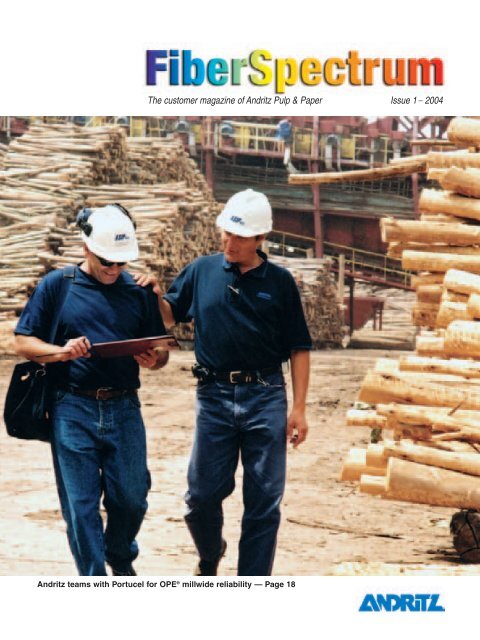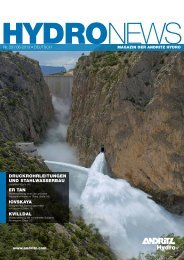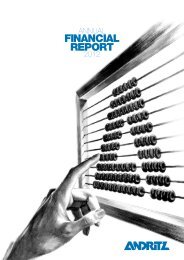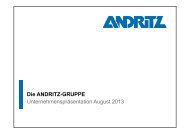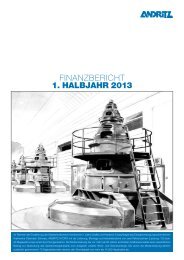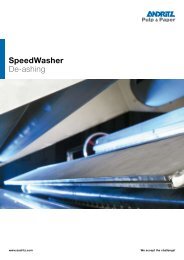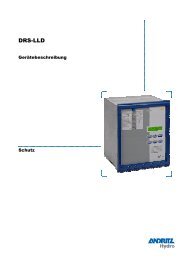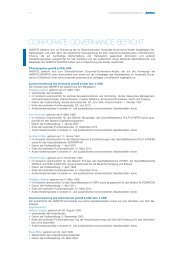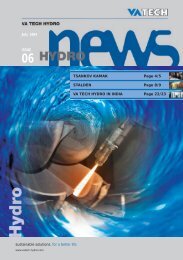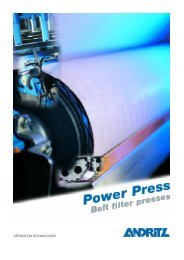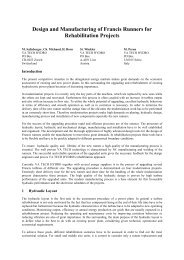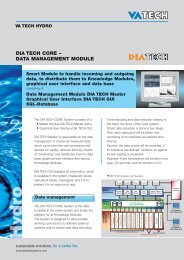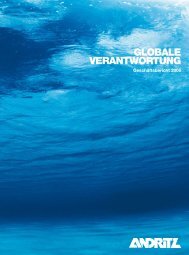The customer magazine of Andritz Pulp & Paper Issue 1— 2004
The customer magazine of Andritz Pulp & Paper Issue 1— 2004
The customer magazine of Andritz Pulp & Paper Issue 1— 2004
Create successful ePaper yourself
Turn your PDF publications into a flip-book with our unique Google optimized e-Paper software.
<strong>The</strong> <strong>customer</strong> <strong>magazine</strong> <strong>of</strong> <strong>Andritz</strong> <strong>Pulp</strong> & <strong>Paper</strong> <strong>Issue</strong> 1 — <strong>2004</strong><br />
<strong>Andritz</strong> teams with Portucel for OPE ® millwide reliability — Page 18
FiberSpectrum is published by:<br />
<strong>Andritz</strong> AG<br />
Stattegger Strasse 18<br />
A-8045 Graz, Austria<br />
Tel: +43 316 6902 0<br />
Managing Editor:<br />
Robert Puhr<br />
robert.puhr@andritz.com<br />
Editorial Board:<br />
Petra Binder, Regina Edelmayer,<br />
Hannes Geiger, Bjørn Hansen,<br />
Riitta Jantunen, Reijo Korhonen,<br />
Florence Lecorne-Ulm, Jay Miele,<br />
Pirjo Nousjoki, Mia Passi, Mikko<br />
Pfaffli, Pekka Saares and<br />
Manuela Wagner.<br />
Contributing Writers:<br />
Martin Koepenick<br />
Hugh O’Brian<br />
Contributing Photographer:<br />
Tom Grow<br />
Graphic Design:<br />
Morrison Graphic Design<br />
morrison@cserv.net<br />
Copyright<br />
© <strong>Andritz</strong> AG, <strong>2004</strong>. All rights reserved. No<br />
part <strong>of</strong> this publication may be reproduced<br />
without permission <strong>of</strong> the publisher.<br />
2 FiberSpectrum <strong>Issue</strong> 1 — <strong>2004</strong><br />
M A G A Z I N E<br />
<strong>The</strong> Web edition <strong>of</strong> FiberSpectrum <strong>of</strong>fers additional articles, downloads, news, information, and contact<br />
information. We encourage you to visit: www.fiberspectrum.andritz.com or www.andritz.com<br />
Contents<br />
<strong>Pulp</strong> & <strong>Paper</strong><br />
A message from the <strong>Andritz</strong> P&P Management<br />
Downflow ups strength and capacity<br />
New digester technology at UPM-Kymmene, Kuusankoski<br />
Big ideas, compact packages<br />
Metsä Tissue succeeds with Compact Concept Mill in Sweden<br />
Hallsta mill relies on RTS TM<br />
Holmen <strong>Paper</strong>'s TMP refiners reduce energy, improve quality<br />
Portucel teams with <strong>Andritz</strong><br />
OPE ® is employed in Portugal for millwide reliability<br />
Catastrophe to “trophy” in Slovenia<br />
Vipap Videm Krsko starts up turnkey DIP line from <strong>Andritz</strong><br />
News from the world <strong>of</strong> <strong>Andritz</strong>
Bernhard and I hope you<br />
enjoy reading this issue <strong>of</strong><br />
FiberSpectrum. As head <strong>of</strong> the<br />
<strong>Pulp</strong> Mill Technologies sector <strong>of</strong><br />
<strong>Andritz</strong>, I would like to direct your<br />
attention to the articles about<br />
UPM-Kymmene's Kuusankoski<br />
mill (page 4) and Portucel's<br />
Setubal mill (page 18). In<br />
addition, our Wood Processing<br />
group contributed to the<br />
success <strong>of</strong> Holmen <strong>Paper</strong>'s<br />
Hallstavik operations (page 14).<br />
<strong>Andritz</strong> is proud to have played<br />
a major role in these projects.<br />
<strong>The</strong> year 2003 was a difficult<br />
one for most <strong>of</strong> the industry,<br />
including suppliers. Still, we are<br />
fortunate to have been chosen<br />
for major greenfield projects,<br />
such as the Veracel project in<br />
Brazil. We are well underway<br />
with large chemical pulping<br />
and recovery projects in Chile,<br />
Germany, and Finland. Of<br />
special note is the very<br />
successful start-up in August<br />
2003 for a new <strong>Andritz</strong> fiberline in the USA.<br />
Within nine days, the line reached design production, has<br />
produced on-grade pulp, and the average production has<br />
been above the design rate ever since. <strong>The</strong>se are<br />
exceptional results!<br />
We thank you for your continued confidence in our<br />
people, our technology, and our service.<br />
Sincerely,<br />
Markku Hänninen<br />
Head <strong>of</strong> <strong>Pulp</strong> Mill Technologies<br />
markku.hanninen@andritz.com<br />
<strong>Pulp</strong>&<strong>Paper</strong><br />
Markku Hänninen Bernhard Rebernik<br />
Our strategy to create full-line<br />
competence within <strong>Andritz</strong><br />
proves to be successful. For<br />
example, we sold two complete<br />
3000 admt/d pulp drying lines<br />
in 2003 (China and Brazil)<br />
which include the recently<br />
acquired Fläkt Dryer technology.<br />
And, we now have the<br />
potential to supply complete<br />
mechanical pulping systems<br />
with Flash dryers.<br />
In this issue, you will find<br />
articles <strong>of</strong> interest for tissue<br />
producers, such as the CCM<br />
project for Metsä Tissue (page<br />
8). <strong>The</strong> TissueFlex shoe<br />
press technology is now wellproven<br />
with 10 machines in<br />
operations producing supers<strong>of</strong>t<br />
tissue quality. <strong>The</strong> most recent<br />
example is Wepa in Germany,<br />
which had an excellent start-up.<br />
TMP producers will want to<br />
read the results <strong>of</strong> Holmen<br />
<strong>Paper</strong>'s RTS TM refiner upgrade<br />
project (page 14). And,<br />
recycled fiber producers will be interested in the <strong>Andritz</strong><br />
turnkey DIP line for Krsko in Slovenia (page 24).We<br />
continue to make investments in the service area, most<br />
recently with the acquisition <strong>of</strong> Fiedler — a major supplier <strong>of</strong><br />
screen baskets for our industry.<br />
We appreciate your feedback and will consider every<br />
suggestion.<br />
Sincerely,<br />
Bernhard Rebernik<br />
Head <strong>of</strong> <strong>Paper</strong> Mill Technologies<br />
bernhard.rebernik@andritz.com<br />
<strong>Issue</strong> 1 — <strong>2004</strong> FiberSpectrum 3
UPM-Kymmene<br />
Downflow Ups Strength<br />
and Capacity at Kuusankoski<br />
<strong>The</strong> history <strong>of</strong> Kymmene Corporation started in Kuusankoski, Finland<br />
in the year 1872. Situated on the banks <strong>of</strong> the Kymi River, the mill was<br />
well-positioned amidst water, fiber and energy resources.<br />
Sulphate pulp production began in<br />
1964 and the pulp mill has steadily<br />
progressed over time — from 150,000<br />
t/a to today's 500,000 t/a <strong>of</strong> bleached<br />
hardwood and s<strong>of</strong>twood.<br />
4 FiberSpectrum <strong>Issue</strong> 1 — <strong>2004</strong><br />
Today, with major modernizations to<br />
both the pulp mill and paper mill, UPM-<br />
Kymmene in Kuusankoski continues to<br />
be well-positioned as a supplier <strong>of</strong> newgeneration<br />
publication papers on its five<br />
paper machines.<br />
Above: Auvo Kettunen, Development Manager for Cooking Processes at <strong>Andritz</strong>.<br />
Right: <strong>The</strong> s<strong>of</strong>twood digester (left) rebuilt by <strong>Andritz</strong> produces 200,000 t/a bleached<br />
s<strong>of</strong>twood pulp. It utilizes Downflow Lo-Solids ® Cooking and Enhanced Alkali Pr<strong>of</strong>ile<br />
Cooking (EAPC) to improve pulp strength and yield. <strong>The</strong> new 1000 t/d <strong>Andritz</strong> digester<br />
(right) with Lo-Level ® Feed and Lo-Solids ® Cooking has performed with 100% availability.
New digester<br />
for hardwood line<br />
"We had two Ahlstrom digesters from<br />
the mid-1960's and they were running<br />
good," says Markku Laaksonen, <strong>Pulp</strong><br />
Production Manager at Kuusankoski.<br />
"<strong>The</strong> only problem was that, due to<br />
their age, they were very badly corroded.<br />
<strong>The</strong> shells were fabricated from<br />
carbon steel. <strong>The</strong> cost <strong>of</strong> maintenance<br />
and repair was quite high."<br />
Another factor was the paper mill's<br />
program to increase capacity, which put<br />
new demands on the pulp mill.<br />
"<strong>The</strong> starting point for choosing the<br />
cooking process is always the same —<br />
produce high quality pulp at low costs,<br />
simply and safely," Laaksonen says.<br />
"When we got approval to purchase the<br />
new digester, we were satisfied that the<br />
<strong>Andritz</strong> single-vessel hydraulic technology<br />
would meet our goals. We thought<br />
that the Diamondback ® Chip Bin and<br />
the feeding system were simple and<br />
good. We also felt we would get more<br />
yield from the <strong>Andritz</strong> system, compared<br />
to their competitors."<br />
<strong>The</strong> new 1000 t/d <strong>Andritz</strong> digester, with<br />
Lo-Level ® Feed and Lo-Solids ® Cooking,<br />
was started up in September 1999 after<br />
a quick 14-month delivery time.<br />
"Start-up <strong>of</strong> the <strong>Andritz</strong> digester was<br />
very easy," Laaksonen remembers. "We<br />
had a one-month water run before we<br />
started cooking. We ramped the temperatures<br />
up and had time to adjust the<br />
control loops, and get everything right.<br />
Chip feeding to the digester began on<br />
5 September and that same evening,<br />
first-class pulp was being produced.<br />
"It is a very easy digester to run,"<br />
Laaksonen explains. "Availability has<br />
been100%. We are easily getting 1100 t/d<br />
or more. We have had very few<br />
disturbances, and no scaling problems,<br />
<strong>of</strong> which we had quite a lot with the old<br />
digester."<br />
Markku Laaksonen, <strong>Pulp</strong> Production<br />
Manager at Kuusankoski.<br />
UPM-Kymmene<br />
<strong>The</strong> UPM-Kymmene Group, with<br />
sales over 10 billion euros and<br />
36,000 employess, is one <strong>of</strong> the<br />
biggest forest industry enterprises<br />
in the world.<br />
Although UPM-Kymmene can<br />
trace its roots back to the 1870's in<br />
Finland, the current corporation was<br />
created in 1995 with the merger <strong>of</strong><br />
Kymmene Corporation and United<br />
<strong>Paper</strong> Mills Ltd. (Repola Ltd.).<br />
<strong>The</strong> company focuses on maga-<br />
zine papers, newsprint, fine and<br />
specialty papers, converting mate-<br />
rials, and wood products. UPM-<br />
Kymmene has production in 17<br />
countries with total papermaking<br />
capacity <strong>of</strong> 8.6 million t/a.<br />
<strong>Issue</strong> 1 — <strong>2004</strong> FiberSpectrum 5
Downflow Lo-Solids ® /<br />
EAPC Cooking<br />
<strong>The</strong> Downflow version <strong>of</strong> Lo-Solids ®<br />
Cooking extends the first cooking<br />
zone to the old extraction screens<br />
<strong>of</strong> a conventional digester. This<br />
increases the total production capa-<br />
city <strong>of</strong> the digester. Before the sec-<br />
ond cooking stage there is a short<br />
counter-current displacement zone<br />
(the heart <strong>of</strong> the Lo-Solids ® cooking<br />
process). As with all Lo-Solids ®<br />
cooking processes, the dissolved<br />
organic substances are extracted<br />
before bulk delignification occurs,<br />
while the akali pr<strong>of</strong>ile is optimum.<br />
Cleaner pulp is produced, tear<br />
strength is preserved, and bleaching<br />
is done more efficiently since the<br />
dissolved organics are eliminated.<br />
As the cooking time is longer,<br />
and even though the alkali concen-<br />
trations are lower with Downflow,<br />
cooking temperatures can be much<br />
lower compared to conventional<br />
cooking. <strong>The</strong> combination increas-<br />
es pulp strength.<br />
Enhanced Alkali Pr<strong>of</strong>ile Cooking<br />
(EAPC) can be used when maxi-<br />
mum tear strength is needed.<br />
EAPC raises the alkali charge and<br />
the alkali concentration in the<br />
cooking stage so that residual<br />
alkali from the lower extraction is<br />
high. This further reduces the<br />
cooking temperature. This alkali-<br />
rich black liquor is recycled to the<br />
impregnation zone and consumed<br />
there. With a combination <strong>of</strong><br />
Downflow Lo-Solids ® and EAPC, it<br />
is easy to optimize the effective<br />
alkali pr<strong>of</strong>ile — giving the operator<br />
the ability to select for pulp yield,<br />
pulp strength, and bleachability.<br />
6 FiberSpectrum <strong>Issue</strong> 1 — <strong>2004</strong><br />
"<strong>The</strong> Diamondback ®<br />
Chip Bin and the<br />
feeding system are<br />
simple and good,"<br />
according to<br />
Laaksonen.
Aki Korpela records the results <strong>of</strong> pulp tests.<br />
S<strong>of</strong>twood strength has improved significantly<br />
with Downflow Lo-Solids ® Cooking.<br />
Today, the line produces 300,000 t/a<br />
<strong>of</strong> bleached hardwood pulp. <strong>Pulp</strong> properties<br />
are good. Kappa 18 is easily<br />
reached at a high viscosity around<br />
1400 mg/ml. Total rejects have averaged<br />
0.8% and wood consumption is<br />
down 3%. <strong>The</strong> pulp bleaches to its target<br />
91 ISO using less ECF bleaching<br />
chemicals than before.<br />
Downflow Lo-Solids ®<br />
retr<strong>of</strong>it for s<strong>of</strong>twood line<br />
Kuusankoski's old s<strong>of</strong>twood digester,<br />
supplied by Ahlstrom in the 1970's, was<br />
running vapor-phase technology with a<br />
black liquor impregnation tower. Over<br />
the years, corrosion took its toll. A corroded<br />
impregnation tower was replaced<br />
in 1993.<br />
"This digester has always experienced<br />
hanging problems on pine, due<br />
to its height and narrow diameter,"<br />
Laaksonen confides. "Plus, we had<br />
some pulp strength problems in the<br />
past which caused us to buy pulp from<br />
the outside."<br />
UPM-Kymmene chose to rebuild,<br />
rather than replace, the s<strong>of</strong>twood<br />
digester in 2000 and again selected<br />
<strong>Andritz</strong>. This time, the decision was<br />
made to rebuild the two-vessel vaporphase<br />
digester with a combination <strong>of</strong><br />
Downflow Lo-Solids ® and Enhanced<br />
Alkali Pr<strong>of</strong>ile Cooking (EAPC) to<br />
improve pulp strength and yield.<br />
Current pulp production for the s<strong>of</strong>twood<br />
line is 200,000 t/a bleached. <strong>The</strong><br />
kappa target is 30 and the brightness<br />
target is 87 ISO.<br />
<strong>The</strong> newly rebuilt s<strong>of</strong>twood digester<br />
started up in January 2001. Since that<br />
time, the mill has run extensive strength<br />
tests on the s<strong>of</strong>twood pulp. Remarkably,<br />
strength delivery in the blowline has gone<br />
from 84.7% before the rebuild to 90.9%<br />
with Downflow Lo-Solids ® Cooking.<br />
"<strong>The</strong> quality <strong>of</strong> the pulp is good and<br />
homogeneous," Laaksonen says. "We<br />
chose the <strong>Andritz</strong> technology to get<br />
more strength in the pulp and we have<br />
achieved this. All our paper machines<br />
now use the pulp from our own line and<br />
we have stopped purchasing s<strong>of</strong>twood<br />
pulp from the outside."<br />
Since the initial rebuild, <strong>Andritz</strong> has<br />
further refined the digester to increase<br />
capacity and runnability <strong>of</strong> Kuusankoski's<br />
s<strong>of</strong>twood line.<br />
A new screen zone was installed during<br />
summer shutdown (2003) that decreased<br />
the alkali charge, lowered the cooking<br />
temperature, and further increased<br />
pulp strength.<br />
"<strong>The</strong> digester is running very stably<br />
and pulp strength has increased," says<br />
Laaksonen. "Our aim is to get more<br />
production with stable quality out <strong>of</strong> this<br />
digester. <strong>The</strong> demand is there." ■<br />
Find out more at<br />
www.fiberspectrum.andritz.com<br />
<strong>The</strong> modern fiberline control room for wood processing, hardwood pulp and s<strong>of</strong>twood<br />
pulp lines at Kuusankoski. Esa Vanhalakka is the operator in the foreground, and Niko<br />
Saarinen is in the background.<br />
<strong>Issue</strong> 1 — <strong>2004</strong> FiberSpectrum 7
Metsä Tissue<br />
Big ideas come in compact<br />
packages in Småland.<br />
Metsä Tissue's two mills in the Småland area <strong>of</strong> Sweden have been quietly at the forefront in two new and<br />
extremely interesting developments in the tissue industry: the Compact Concept Mill and the TissueFlex*<br />
press. <strong>Andritz</strong> played a key role in both.<br />
Roland Leidefors, Machine Operator, at the wet end <strong>of</strong> the<br />
<strong>Andritz</strong> CrescentFormer machine (PM 5) at Metsä Tissue's<br />
Nyboholm mill. Metsä's Compact Concept Mill focuses on<br />
investment efficiency and production efficiency. "<strong>The</strong> operator's<br />
goal is to maximize quality and efficiency <strong>of</strong> final output,<br />
not just build parent rolls as fast as possible."<br />
8 FiberSpectrum <strong>Issue</strong> 1 — <strong>2004</strong><br />
* Trademark <strong>of</strong> Voith, cooperation partner <strong>of</strong> <strong>Andritz</strong> in the field <strong>of</strong> tissue
Clear focus on markets<br />
and pr<strong>of</strong>its<br />
Metsä Tissue is a recognized innovator<br />
in the European tissue business. With<br />
an annual capacity <strong>of</strong> 450,000 tonnes,<br />
it is number six in world rankings.<br />
Metsä Tissue production units are<br />
located in Sweden, Finland, Germany,<br />
and Poland. <strong>The</strong> company has a clear<br />
strategy focusing specifically on market<br />
sectors where it can achieve<br />
respectable market position.<br />
Metsä Tissue, formerly known as<br />
Metsä Serla, has nine mills, with three<br />
located in Sweden. Beginning in <strong>2004</strong>,<br />
the Metsäliitto Group became the principal<br />
owner <strong>of</strong> Metsä Tissue (66%<br />
share). This ownership restructuring<br />
supports Metsä Tissue's activities to<br />
further develop its business to become<br />
the world´s top supplier <strong>of</strong> Tissue and<br />
Baking & Cooking products.<br />
Jarkko Kaplin is the Supply Team<br />
Manager for Metsä Tissue in Sweden.<br />
In this role, Kaplin is responsible for<br />
production at the company's three<br />
Swedish mills. <strong>The</strong> Mariestad mill has<br />
Operator Mariana Kjell, sets production<br />
targets on the control panel <strong>of</strong> the Perini<br />
converting equipment.<br />
Jarkko Kaplin, Supply Team Manager for Sweden. "CCM removes the traditional boundaries<br />
— not only with the production equipment, but also employee workflows and attitudes."<br />
a capacity <strong>of</strong> around 75,000 t/a <strong>of</strong> both<br />
consumer and away-from-home grades.<br />
<strong>The</strong> Nyboholm and Pauliström mills,<br />
located within 8 km <strong>of</strong> each other in the<br />
Småland region, have a total capacity<br />
<strong>of</strong> 45,000 t/a <strong>of</strong> converted products.<br />
<strong>The</strong> majority <strong>of</strong> this tonnage goes into<br />
consumer grades.<br />
Comfort, and quality,<br />
for every day<br />
Kaplin explains some <strong>of</strong> the company<br />
background and strategy: "Metsä Tissue<br />
is a very focused company, with Europe<br />
as our main market area. Turnover was<br />
around 659 million euros in 2002 and<br />
about 55% <strong>of</strong> our production went to<br />
continental Europe, 35% to the Nordic<br />
countries, and 10% to other markets.<br />
We are strongest in the Nordic countries<br />
where we have approximately 45% market<br />
share, depending on the grade. Of<br />
course, when you have a high market<br />
share, it is a tough fight to keep this<br />
level, but we have been able to maintain<br />
it based on factors such as quality, service,<br />
and delivery times — a function <strong>of</strong><br />
our localness so to say. Quality is clearly<br />
a very important factor for us."<br />
Indeed, the push to increase quality<br />
was the driving force for two recent<br />
investments in the Nyboholm and<br />
Pauliström units, which are collectively<br />
referred to within Metsä Tissue as "the<br />
Småland mills." During the period<br />
1999-2000, the Småland mills underwent<br />
major investments.<br />
Following these and later investments<br />
in converting technology, says Kaplin, the<br />
Småland mills are presently the "most<br />
complete invested operations in the company,<br />
and also produce the best quality."<br />
<strong>Issue</strong> 1 — <strong>2004</strong> FiberSpectrum 9
Jan Eklund, Technical Manager for the Småland mills, with Erwin Walcher, <strong>Andritz</strong><br />
Service Engineer for Tissue Machines, at the reel <strong>of</strong> the 1000 m/min PM 5 at Nyboholm.<br />
"<strong>Andritz</strong> was willing to work with us on this concept, which wasn't exactly an <strong>of</strong>f-theshelf<br />
solution. <strong>The</strong>y listened and gave us what we wanted."<br />
Pioneering a new concept<br />
In 1999, Metsä Tissue introduced a new<br />
concept — the Compact Concept Mill or<br />
CCM — for tissue production focused<br />
on optimizing investment efficiency and<br />
production efficiency. <strong>The</strong> idea <strong>of</strong> CCM<br />
is to get better pr<strong>of</strong>itability by locating<br />
the papermaking and converting operations<br />
into one seamless process. In<br />
other words, CCM blurs the traditional<br />
boundaries between the paper and con-<br />
10 FiberSpectrum <strong>Issue</strong> 1 — <strong>2004</strong><br />
verting sides. "<strong>The</strong> boundaries, including<br />
employee workflows and attitudes,<br />
have disappeared," Kaplin says.<br />
This new concept, combined with a<br />
very steady paper machine production<br />
rate, leads to higher overall production<br />
efficiency from the total assets. "<strong>The</strong><br />
layout and employee attitude is such,"<br />
says Jan Eklund, Technical Manager for<br />
the Småland mills, "that the machine<br />
operator keeps a close eye on the<br />
progress in converting. <strong>The</strong> operator's<br />
goal is to maximize the quality and efficiency<br />
<strong>of</strong> our final output, not just building<br />
parent rolls as fast as possible."<br />
Eklund explains some <strong>of</strong> the background:<br />
"Back in 1997 we were looking<br />
at alternatives for our future growth. We<br />
wanted a concept that was sized right<br />
for our market, where we already have<br />
a large share. We needed something<br />
that gave us premium quality, investment<br />
efficiency, and production efficiency<br />
in a small package at a good<br />
price. <strong>The</strong>refore, we came up with the<br />
Compact Concept Mill Project.<br />
"To be honest, I was hesitant at first<br />
when it was suggested that we build a<br />
paper machine designed for 1000 m/min<br />
and not higher. <strong>Paper</strong>makers always<br />
want something bigger and faster than<br />
what anyone else has. It is also natural<br />
in this industry to build a machine<br />
designed for one speed but then to
slowly move up the speed curve. But<br />
eventually, I was convinced that if we<br />
had the discipline to design, build, and<br />
pay for only the specific functions we<br />
needed, we could get a more rapid<br />
payback from running the mill at steady<br />
output."<br />
Working closely with a consultant,<br />
Metsä Tissue started to define the concept<br />
in more detail. Nyboholm was chosen<br />
for this concept, says Eklund, based<br />
on the special mentality and enthusiasm<br />
that is present in the labor force.<br />
As the project developed and suppliers<br />
were chosen, an efficiency task<br />
force team was formed. This included<br />
all <strong>of</strong> the suppliers to the project. This<br />
team met regularly to make sure that all<br />
the participants in the project were<br />
communicating and moving in the same<br />
direction with the efficiency and quality<br />
targets clearly in focus.<br />
Small is beautiful,<br />
and efficient<br />
Metsä Tissue decided from the start<br />
that it did not want to have the world's<br />
fastest or biggest line. Using "small<br />
can be beautiful" thinking, the design<br />
team decided to keep the line simple.<br />
To keep costs down, the line would<br />
include one paper machine, one converting<br />
line, one wrapper/bundler, and<br />
one palletizer. In this single-line scenario,<br />
selection <strong>of</strong> the individual<br />
machines was critical to the success<br />
<strong>of</strong> the CCM.<br />
<strong>The</strong> <strong>Andritz</strong> tissue machine was<br />
designed to run at about 1000 m/min.<br />
<strong>The</strong> theory was that, for this mill, the<br />
1000 m/min speed would deliver better<br />
overall efficiency than would a higher<br />
speed machine.<br />
Another interesting feature is the<br />
physical layout <strong>of</strong> the line. "As part <strong>of</strong><br />
this focus on simplicity and efficiency,<br />
we also wanted to emphasize the<br />
teamwork aspect. So we gave thought<br />
to devising ways to integrate the line so<br />
there are virtually no visible boundaries<br />
between the papermaking and converting<br />
operations," Eklund says.<br />
From the control room, the operators<br />
can see almost the entire process<br />
from the paper machine<br />
headbox through to finished<br />
product on pallets going out<br />
to the loading bay. This, says<br />
Eklund, gives the shift personnel<br />
more incentive to<br />
work together to keep the<br />
entire line running well<br />
rather than focusing on just one unit.<br />
By laying the line out in this manner,<br />
the paper machine operator has a secondary<br />
responsibility to help the converting<br />
operators, which is something<br />
that is almost unheard <strong>of</strong> in the traditional<br />
mill where there are physical<br />
boundaries, and <strong>of</strong>ten long distances,<br />
between the papermaking and converting<br />
operations.<br />
Here's a quick test for you:<br />
Which company is Scandinavia's<br />
largest importer and distributor<br />
<strong>of</strong> plush animal toys?<br />
(Hint…it's not Toys ‘R’ Us).<br />
Actually, somewhat surprisingly,<br />
it is Metsä Tissue! <strong>The</strong> company<br />
gives away s<strong>of</strong>t lambs (Lambi<br />
brand) as part <strong>of</strong> its brand promo-<br />
tion campaign. Over one million<br />
super-s<strong>of</strong>t lambs are given to loyal<br />
buyers <strong>of</strong> Lambi tissue products.<br />
Metsä Tissue has built the Lambi<br />
brand up to be the<br />
leading premium<br />
tissue product:<br />
bathroom tissue,<br />
household towels,<br />
all-round towels,<br />
and handkerchiefs.<br />
As further indication <strong>of</strong> it success,<br />
Lambi was recently named the<br />
best tissue product in Sweden in<br />
a survey done by the Dagens<br />
Nyheter, the country's largest<br />
daily newspaper.<br />
<strong>Issue</strong> 1 — <strong>2004</strong> FiberSpectrum 11
Nils-Erik Olsen, Machine Operator, on the<br />
walkway <strong>of</strong> PM6 at Paulistrom. A TissueFlex TM<br />
shoe press was added to the machine in April<br />
2000. This TissueFlex TM at Paulstrom was<br />
among the first installations based upon the<br />
experience Voith had with shoe presses for<br />
other paper grades.<br />
12 FiberSpectrum <strong>Issue</strong> 1 — <strong>2004</strong><br />
Smooth start-up for the line<br />
PM 5 is a CrescentFormer machine<br />
from <strong>Andritz</strong>. <strong>The</strong> company chose<br />
<strong>Andritz</strong> after talking with all <strong>of</strong> the tissue<br />
machine suppliers. Says Eklund,<br />
"<strong>Andritz</strong> was willing to work with us on<br />
this concept, which wasn't exactly an<br />
<strong>of</strong>f-the-shelf solution. <strong>The</strong>y listened and<br />
gave us what we wanted.<br />
"Essentially, everything that <strong>Andritz</strong><br />
was responsible for, including stock<br />
preparation and PM 5, started well,"<br />
Eklund says. "After start-up, the <strong>Andritz</strong><br />
machine ran for 13 hours without a<br />
break. It started so well that initially the<br />
converting line could not keep up. But,<br />
we soon got everything into balance."<br />
<strong>The</strong> bottom line is that all this emphasis<br />
on simplification <strong>of</strong> the machinery and<br />
systems led to very significant savings<br />
in the purchase price <strong>of</strong> the equipment.<br />
"<strong>The</strong> key thing is that we were looking<br />
at efficiency <strong>of</strong> the whole line over a<br />
longer period," Eklund says. "It doesn't<br />
make much sense to have a paper<br />
machine that can run very fast some <strong>of</strong><br />
the time, but doesn't keep pace all the<br />
time. Or, one that runs too fast for the<br />
converting lines."<br />
Quality was clearly the number one priority with the TissueFlex project at Pauliström.<br />
Bulk increased 13-22% and there have been important improvements in absorption, uniformity,<br />
and handfeel.<br />
Pauliström gets TissueFlex TM<br />
press for bulk<br />
Following the CCM project, and in<br />
keeping with the emphasis that Metsä<br />
Tissue has on quality, the company<br />
added a TissueFlex shoe press on its<br />
PM 6 at the Pauliström mill in April<br />
2000. This was among the first installations<br />
in the world <strong>of</strong> this tissue pressing<br />
concept. <strong>The</strong> TissueFlex version was<br />
developed based upon the extensive<br />
experience Voith (<strong>Andritz</strong>'s cooperation<br />
partner for tissue machines) had with<br />
shoe presses for other paper grades.<br />
<strong>The</strong> principle <strong>of</strong> TissueFlex is to<br />
spread the press impulse out over a larger<br />
area to help retain bulk in the sheet.
Quality was clearly the number one<br />
priority with the TissueFlex project at<br />
Pauliström and it is clear that quality<br />
has improved. After the new press was<br />
installed, testing by Metsä Tissue<br />
showed that bulk had risen between 13<br />
and 22%, with the largest increase<br />
coming on the lower-weight toilet<br />
grades. In addition, the mill has also<br />
seen important improvements in<br />
absorption properties <strong>of</strong> the sheet, as<br />
well as uniformity and handfeel.<br />
Prior to the installation <strong>of</strong> the<br />
TissueFlex, the 2.7 m wide PM 6 had<br />
two presses against the Yankee dryer.<br />
In the rebuild, the presses were<br />
replaced with the TissueFlex press<br />
roll against the Yankee. As was expected,<br />
after-press dryness is clearly lower<br />
now, compared to the time when the<br />
machine had two presses.<br />
Eklund says that the TissueFlex<br />
has been a big asset for developing new<br />
Lambi (see sidebar page 11) qualities.<br />
Getting value<br />
for money<br />
Overall, it is clear that Metsä Tissue<br />
made good investments in Småland by<br />
carefully targeting new technology to<br />
produce quality that consumers are willing<br />
to pay for. It has also been cautious<br />
about not buying more technology than<br />
it really needs. In this manner, <strong>Andritz</strong> is<br />
a key partner in providing exactly the<br />
right solutions to help Metsä Tissue<br />
meet these goals.<br />
<strong>The</strong> people from the Småland region<br />
<strong>of</strong> Sweden are famous for being very<br />
careful with their money and resources.<br />
<strong>The</strong>se investments in the Småland mills<br />
are an excellent example <strong>of</strong> how small<br />
and simple can <strong>of</strong>ten be the most pr<strong>of</strong>itable<br />
strategy. ■<br />
Find out more at<br />
www.fiberspectrum.andritz.com<br />
"We can't afford to re-invent the wheel at each mill." Magnus Dahlblom (left) meets with<br />
Product Improvement Team members Hannu Riekkola, Kristina Mast, Lars Lindqvist and<br />
Bo Sjöström. Dahlblom was formerly a Project Manager at Metsä Tissue's Competence<br />
Center in Raubach, Germany and is now Production Manager at the Småland mills.<br />
<strong>The</strong> Kingdom<br />
<strong>of</strong> Crystal<br />
In the middle <strong>of</strong> the 18th<br />
century, German immigrants<br />
established the province <strong>of</strong><br />
Småland as the home <strong>of</strong> the<br />
Swedish glass-making<br />
industry.<br />
A very large province in<br />
Sweden, Småland also is<br />
home to vast forests and<br />
pleasant lakes. This region<br />
has many coastal towns that<br />
stretch along the Baltic. <strong>The</strong><br />
Mörrumsån River is noted<br />
for salmon and sea trout and<br />
Lake Vättern for char fishing.<br />
Three-quarters <strong>of</strong> the<br />
Swedish glassworks are<br />
found in the counties <strong>of</strong><br />
Kronoberg and Kalmar.<br />
<strong>The</strong> glassworks, where<br />
craftsmen can still be<br />
observed hand-blowing<br />
glass, are open to visitors.<br />
Visitors may also be invited<br />
to a hyttssill — a traditional<br />
evening <strong>of</strong> entertainment<br />
including food <strong>of</strong> fried her-<br />
rings, sausages and potatoes<br />
baked around the glass<br />
furnace, served with beer<br />
and schnapps.<br />
<strong>Issue</strong> 1 — <strong>2004</strong> FiberSpectrum 13
Holmen <strong>Paper</strong><br />
Hallsta mill relies on RTS TM to raise<br />
TMP output while cutting energy costs<br />
<strong>Andritz</strong> has worked very closely with Holmen <strong>Paper</strong> to get more output from their TMP 3 line through the<br />
addition <strong>of</strong> two RTS TM refiners. <strong>The</strong> results have been excellent — energy savings <strong>of</strong> more than 300 kWh/tonne<br />
and improved quality. At the same time, the refiners gave a major boost in the line's production capacity.<br />
Mikael Wahlgren, Manager <strong>of</strong> Mechanical <strong>Pulp</strong> Production at the Hallsta mill, with an<br />
<strong>Andritz</strong> twin dewatering screw in the background.<br />
14 FiberSpectrum <strong>Issue</strong> 1 — <strong>2004</strong><br />
Holmen <strong>Paper</strong>'s Hallsta mill in Hallstavik,<br />
Sweden started newsprint production in<br />
1915 and has now developed into one<br />
<strong>of</strong> the world's largest and most modern<br />
production facilities for high quality<br />
wood-containing printing papers. Annual<br />
paper production capacity at the<br />
mill has risen to nearly 800,000 tonnes.<br />
During the past 20 years, Hallsta has<br />
placed increasing emphasis on moving<br />
up the value ladder. It has progressively<br />
been making more improved newsprint,<br />
SC, and other specialty printing papers,<br />
while at the same time phasing out<br />
production <strong>of</strong> bulk grades.<br />
As part <strong>of</strong> its multi-year, multi-million<br />
Euro upgrading process, Hallsta recently<br />
modernized numerous parts <strong>of</strong> the<br />
mill to get better quality, output, and<br />
environmental efficiency. <strong>The</strong> centerpiece<br />
<strong>of</strong> the latest round <strong>of</strong> investments<br />
was the enormous PM 11 which started<br />
up in April 2002. This new machine,<br />
at 8.6 m trim width and capacity <strong>of</strong><br />
330,000 t/a, is focused on MF <strong>magazine</strong><br />
papers and improved newsprint.<br />
It replaced an older, smaller machine<br />
and created an increased demand for<br />
pulp on the order <strong>of</strong> 110,000 t/a.<br />
To feed PM 11 and to meet the<br />
increased pulp quality requirements,<br />
major investments were made in the<br />
woodyard, TMP lines, and bleaching<br />
areas <strong>of</strong> the mill. <strong>Andritz</strong> played a key<br />
role at Hallsta by supplying major<br />
pieces <strong>of</strong> equipment in each <strong>of</strong> these<br />
areas for the modernizations.
<strong>The</strong> new <strong>Andritz</strong> 3300 m 3 /d wood line at Hallsta.<br />
<strong>The</strong> Photo shows the Waplans hydrostatic bearing<br />
debarking drum (5.6 m diameter and 36 m long) with<br />
a capacity <strong>of</strong> 175 m 3 sub/hr. For TMP, the debarking<br />
process must guarantee a high level <strong>of</strong> chip<br />
cleanliness (typically bark content <strong>of</strong> 0.1 to 0.2%).<br />
<strong>The</strong> <strong>Andritz</strong> DrumMatic TM control system at Hallsta<br />
ensures uniform cleanliness.<br />
Wood sorting for<br />
natural brightness<br />
In 1999, <strong>Andritz</strong> supplied a new wood<br />
processing line to replace two older<br />
lines, which were scrapped. <strong>The</strong> new<br />
<strong>Andritz</strong> line has a capacity <strong>of</strong> 3,300 m 3<br />
per day and consists <strong>of</strong> a log infeed<br />
system, debarking drum, and chipper.<br />
<strong>The</strong> mill's woodyard plays a key role<br />
in the drive for both product quality and<br />
environmental protection. Here, spruce<br />
logs are sorted as they come into the<br />
mill based on the annual growth rings<br />
in the wood. In a method that Holmen<br />
helped create in the mid-1990's, this<br />
rough sorting is used to separate the<br />
wood into three categories. <strong>The</strong> fastest<br />
growing logs, with the highest annual<br />
growth increments, are used for the<br />
highest brightness pulp.<br />
Lennart Karlsson, Process Engineer.<br />
"We are very satisfied with the installation."<br />
In this manner, says Lennart Karlsson,<br />
Process Engineer at Hallsta, the mill<br />
saves on bleaching chemicals and<br />
reduces the environmental load. "As we<br />
moved to improved grades with higher<br />
brightness requirements, it seemed logical<br />
to attempt to use the natural brightness<br />
<strong>of</strong> the wood," Karlsson says. "So<br />
the brightest chips are used for the highest<br />
qualities, therefore saving bleaching<br />
chemicals and, <strong>of</strong> course, money."<br />
<strong>Issue</strong> 1 — <strong>2004</strong> FiberSpectrum 15
16 FiberSpectrum <strong>Issue</strong> 1 — <strong>2004</strong><br />
TMP upgrade feeds PM 11<br />
<strong>The</strong>re are a total <strong>of</strong> four PMs being fed<br />
by four pulp lines. Three lines run TMP,<br />
and the oldest line, from the early<br />
1960's, runs stone groundwood.<br />
Hallsta tries to focus its pulp lines so<br />
that, essentially, one line feeds one<br />
paper machine. TMP 3 is the one dedicated<br />
to PM 11. When the paper<br />
machine is running full speed (1850<br />
m/min), it consumes around 1,050 t/d<br />
<strong>of</strong> pulp. Before the rebuild, TMP 3 was<br />
only capable <strong>of</strong> making 700 tonnes per<br />
day. Clearly, something had to be done<br />
to increase capacity.<br />
"We were guaranteed savings <strong>of</strong> at least<br />
300 kWh/tonne and that adds up to a lot <strong>of</strong><br />
money over the year." An <strong>Andritz</strong> RTS TM<br />
refiner (model S 3068) connected to a 17<br />
MW motor operating at 2300 rpm.<br />
Faced with this need to produce<br />
more pulp, <strong>Pulp</strong> Mill Manager Mikael<br />
Wahlgren and his team looked at several<br />
alternatives for adding pulp capacity<br />
to TMP 3. With energy costs rising in<br />
Sweden, Wahlgren was also highly<br />
motivated to reduce specific energy<br />
costs for the TMP. <strong>Andritz</strong> worked<br />
closely with Hallsta to explore alternatives<br />
for modernizing TMP 3.<br />
<strong>The</strong> <strong>Andritz</strong> S 3068 refiner, with design<br />
capacity <strong>of</strong> 285 t/d was operating at<br />
350 t/d less than a year after start-up.<br />
An <strong>Andritz</strong> S 3068 replaced an old Jylhä<br />
refiner from the late 1980's. "It was a tight<br />
fit, but the <strong>Andritz</strong> refiners are compact.<br />
Saving space was an added advantage."<br />
Energy savings from<br />
RTS TM refiners<br />
Hallsta's TMP 3 is composed <strong>of</strong> four<br />
parallel lines, each made up <strong>of</strong> one primary<br />
and one secondary refiner. <strong>The</strong><br />
equipment, before the <strong>Andritz</strong> rebuild,<br />
was composed <strong>of</strong> old Jylhä refiners<br />
from the late 1980's. In the end, the mill<br />
decided to install two new <strong>Andritz</strong> RTS TM<br />
refiners in the primary positions on two<br />
<strong>of</strong> the lines.<br />
"Essentially," says Wahlgren, "we<br />
went with the <strong>Andritz</strong> RTS TM technology<br />
because it would save us energy.
“We were guaranteed savings <strong>of</strong> at least<br />
300 kWh/tonne and that adds up to a lot<br />
<strong>of</strong> money over the year. <strong>The</strong> RTS TM was<br />
also a good solution because the<br />
refiners are rather compact. Since TMP<br />
3 is tightly packed into the building,<br />
saving space was an added advantage,"<br />
Wahlgren said.<br />
<strong>The</strong> RTS TM concept is an <strong>Andritz</strong><br />
development which adds a new dimension<br />
to the conventional TMP process —<br />
refiner speed. <strong>The</strong> refiner plates turn<br />
at around 2300 rpm, versus 1500 rpm<br />
for normal refiners. RTS TM raises the<br />
preheating temperature at a controlled<br />
retention time to prevent lignin from<br />
coating the fibers. <strong>Pulp</strong> quality is<br />
improved and the specific energy per ton<br />
<strong>of</strong> pulp produced is significantly reduced.<br />
So far, says Wahlgren, the RTS TM refiners<br />
have worked very well, with energy<br />
consumption well below the previous<br />
levels and the pulp quality is excellent.<br />
"We are saving 300 or more kWh per<br />
tonne and the pulp properties are as<br />
good or better than with the old<br />
refiners. Light scattering, for example,<br />
is even better with the new<br />
RTS TM refiners," he said.<br />
Savings higher<br />
than expected<br />
Karlsson, the Process<br />
Engineer responsible for the<br />
TMP 3 line, was very involved<br />
in the installation, start-up, and<br />
continuing optimization <strong>of</strong> the<br />
RTS TM refiners. "We are very<br />
satisfied with the installation,"<br />
says Karlsson. "It has fulfilled<br />
all <strong>of</strong> the goals as far as<br />
quality is concerned and we<br />
are saving more energy than<br />
<strong>Andritz</strong> guaranteed.<br />
We had been looking for<br />
300 kWh/tonne and are<br />
sometimes getting 350 or<br />
even more. We are using<br />
around 1,600 kWh, although<br />
this varies depending on the<br />
wood quality."<br />
Bleach plant Superintendent, Göran Larsson, near one <strong>of</strong> two new <strong>Andritz</strong> Twin Wire<br />
presses (3.6 m working width) in the post-bleach wash position.<br />
Trials to test capacity<br />
Capacity and throughput on the new line<br />
have also been very good, with the mill<br />
continuing to run trials to see just how<br />
much pulp the RTS TM units are capable<br />
<strong>of</strong> making. Micael Axelfelt, Northern<br />
European Sales Manager for <strong>Andritz</strong>,<br />
Micael Axelfelt, Sales Manager for <strong>Andritz</strong>, with Joakim<br />
Lirfeldt, Maintenance Manager at Hallsta. Axelfelt was<br />
a process engineer at the mill before joining <strong>Andritz</strong>.<br />
works closely with the mill on these<br />
capacity trials. In fact, he has been working<br />
very closely with the Hallsta team for<br />
more than 20 years, as he was a process<br />
engineer at the mill before joining <strong>Andritz</strong>.<br />
<strong>The</strong> idea, says Axelfelt, is to put as<br />
much <strong>of</strong> the tonnage as possible through<br />
the low-energy RTS TM units, to gain both<br />
energy savings as well as improved pulp<br />
quality. In June 2003, the mill succeeded<br />
in producing 15 t/h — the equivalent <strong>of</strong><br />
360 t/d — during trials on the RTS TM line.<br />
<strong>The</strong> capacity <strong>of</strong> TMP 3 is now about<br />
900 tonnes per day, with the disk filter<br />
being the bottleneck in the system.<br />
All in all, the Hallsta team is very<br />
pleased with their choice <strong>of</strong> the <strong>Andritz</strong><br />
RTS TM solution. With high quality pulp,<br />
produced at lower energy costs, feeding<br />
a new paper machine, it looks like<br />
Hallsta will remain a top player in the<br />
mechanical printing paper markets for a<br />
long time to come. ■<br />
Find out more at<br />
www.fiberspectrum.andritz.com<br />
<strong>Issue</strong> 1 — <strong>2004</strong> FiberSpectrum 17
Portucel<br />
Unique team OPEns the way<br />
for millwide reliability<br />
ASIP - Assist ^ encia e Serviços para a<br />
Indústria do Papel, ACE, a specialpurpose<br />
corporation owned by<br />
<strong>Andritz</strong>, Siemens, ATM, and Portucel,<br />
is responsible for the millwide maintenance<br />
at Portucel's Setubal mill in<br />
Portugal.<br />
This is part <strong>of</strong> <strong>Andritz</strong>'s service<br />
concept called Overall Production<br />
Efficiency (OPE ® ) where the goal is to<br />
increase the production <strong>of</strong> a process<br />
line, or entire mill, by leveraging the<br />
overall maintenance activities.<br />
In the case <strong>of</strong> Setubal, the goal was<br />
not just to reduce maintenance costs,<br />
according to Henrique Figueira, <strong>Pulp</strong> and<br />
Energy Production Manager. "Our first<br />
priority was to increase the availability<br />
<strong>of</strong> the installed equipment, through better<br />
maintenance approaches and state-<strong>of</strong>the-art<br />
procedures. We are not interested<br />
in saving money if, for instance, the availability<br />
<strong>of</strong> the equipment decreases. We<br />
want to keep availability at a high level, at<br />
the minimum cost."<br />
Seppo Sandberg, Site Manager for<br />
ASIP and also an <strong>Andritz</strong> employee,<br />
supports the logic to this approach.<br />
"Maintenance cost per tonne <strong>of</strong> pulp<br />
is a key performance indicator,"<br />
Sandberg explains. "Each month we<br />
report on the total maintenance cost per<br />
tonne <strong>of</strong> pulp produced. ASIP's compensation<br />
is based upon achieving key<br />
performance criteria (production, quality,<br />
raw material consumption, safety,<br />
etc.) for each process area and overall.<br />
"As the Site Manager, I have two<br />
simple targets. <strong>The</strong> first is <strong>customer</strong><br />
satisfaction. Without <strong>customer</strong> satisfaction,<br />
the second target is not achievable.<br />
<strong>The</strong> second target is a positive<br />
financial result for my company."<br />
18 FiberSpectrum <strong>Issue</strong> 1 — <strong>2004</strong><br />
<strong>The</strong> drive for more production<br />
Figueira says that the short-term goal is<br />
not only to significantly reduce maintenance<br />
costs, but to increase production for<br />
the same level <strong>of</strong> maintenance spending.<br />
This will reduce maintenance cost/tonne.<br />
<strong>The</strong> benchmark cost before ASIP began<br />
was 35 euros per tonne. Today's target<br />
is 27 euros per tonne. "<strong>The</strong> drive is for<br />
more production at a higher equipment<br />
availability," Figueira says.<br />
"Our first attempt at outsourcing local<br />
maintenance began about eight years<br />
ago in the woodyard area," Figueira<br />
says. "We also did this for the effluent<br />
treatment plant, but only small local<br />
companies were involved at that time."<br />
Left: Henrique<br />
Figueira, <strong>Pulp</strong> and<br />
Energy Production<br />
Manager for Setubal.<br />
"We want to keep<br />
equipment availability<br />
at a high level, at the<br />
minimum cost."<br />
Right: Seppo<br />
Sandberg (right), Site<br />
Manager for <strong>Andritz</strong>'s<br />
OPE ® team at Setubal,<br />
confers with a pulp<br />
production supervisor<br />
in front <strong>of</strong> the continuous<br />
digester.
ASIP workers replace the bearings on a<br />
back-up turbine generator at the mill.<br />
<strong>The</strong> first major outsourcing contract<br />
Portucel made was for the Power area.<br />
<strong>The</strong>y put the Power and Woodyard areas<br />
together in one contract a couple <strong>of</strong><br />
years ago and first selected another supplier<br />
to do the maintenance. <strong>The</strong>n the<br />
mill awarded a Fiberline maintenance<br />
contract to ASIP at the end <strong>of</strong> 2001.<br />
"In March 2003, we made the decision<br />
to consolidate all the local maintenance<br />
for the whole pulp mill into one<br />
contract with ASIP, as we were satisfied<br />
with what had been done in the<br />
Fiberline area since January 2002,"<br />
Figueira says. <strong>Pulp</strong> production <strong>of</strong> the<br />
mill is now 480,000 t/a.<br />
"We needed a good, dedicated team<br />
with engineering backup," he continues.<br />
"That's why we selected ASIP. <strong>The</strong>y<br />
have the knowledge, the procedures,<br />
and the team to achieve the goals we<br />
have placed on ourselves."<br />
<strong>Issue</strong> 1 — <strong>2004</strong> FiberSpectrum 19
Outsourcing — more than<br />
"labor brokers"<br />
Portucel has had a good relationship<br />
with <strong>Andritz</strong> for years and was open to<br />
discussions about new ways <strong>of</strong> doing<br />
maintenance at a time when <strong>Andritz</strong> was<br />
developing its OPE ® service concept.<br />
"<strong>The</strong> OPE ® concept here at Setubal<br />
is based upon using our process<br />
expertise, our equipment knowledge,<br />
maintenance expertise from ourselves<br />
and Siemens, and the expertise available<br />
at the Setubal mill to form a partnership,"<br />
says Risto Hämäläinen, head<br />
<strong>of</strong> <strong>Pulp</strong> Mill Services for <strong>Andritz</strong>. "This<br />
is not simply labor outsourcing. We're<br />
adding as much value to the production<br />
side as the maintenance side."<br />
"ASIP has very pr<strong>of</strong>essional people at<br />
our mill," Figueira says. "Process and<br />
equipment experts from <strong>Andritz</strong> and<br />
Siemens, their very best specialists from<br />
Austria, Finland, and the USA visited the<br />
mill to evaluate production performance<br />
and conduct higher level process and<br />
technical studies in the fiberline, screening,<br />
recovery, and pulp drying areas."<br />
"This is one <strong>of</strong> the added values we<br />
bring to the <strong>customer</strong> — our process<br />
expertise," Hämäläinen adds. "This was<br />
part <strong>of</strong> our initial proposal to Portucel in<br />
order to distinguish OPE ® from a conventional<br />
maintenance service. All <strong>of</strong><br />
our work, including the special studies,<br />
is designed to help Portucel get better<br />
and more production out <strong>of</strong> this mill."<br />
"Much <strong>of</strong> the main production equipment<br />
we have here is from Ahlstrom<br />
Machinery, which is now a part <strong>of</strong><br />
<strong>Andritz</strong>," Figueira says, "But, even if it<br />
weren’t <strong>Andritz</strong> equipment, I don't think<br />
there would be any risk in getting<br />
<strong>Andritz</strong> involved in an OPE program,<br />
due to the fact that they have their<br />
background in process design, engineering,<br />
equipment design, and manufacturing<br />
<strong>of</strong> the equipment used here."<br />
"We are working with a very enlightened<br />
management at this mill and they<br />
understand the role <strong>of</strong> maintenance in<br />
20 FiberSpectrum <strong>Issue</strong> 1 — <strong>2004</strong><br />
Roberto Lemos, ASIP's specialist for Chemical Recovery, confers with his colleague<br />
from Siemens regarding maintenance activities near the lime kiln. Lemos, a native <strong>of</strong><br />
Brazil, has worked on projects for <strong>Andritz</strong> in South America.<br />
reducing the overall cost <strong>of</strong> a produced<br />
tonne <strong>of</strong> pulp," Sandberg says.<br />
<strong>The</strong> ASIP organization<br />
ASIP consists <strong>of</strong> about 150 people and<br />
includes people who used to work<br />
directly for Portucel.<br />
For strategic reasons, Portucel continues<br />
to staff the workshop and engineering<br />
functions inside Portucel. <strong>The</strong><br />
workshops include the facilities inside<br />
the mill and also some special shops<br />
on the outside. Engineering is responsible<br />
for analyzing process equipment,<br />
supporting capital investments, and<br />
planning for the annual shutdown.<br />
Portucel also maintains the spare<br />
parts stores.<br />
"Our first and most important responsibility<br />
is the daily maintenance <strong>of</strong> the<br />
mill," Sandberg explains. "As a part <strong>of</strong><br />
this, we perform predictive maintenance<br />
on equipment as we build the historical<br />
database about equipment performance.<br />
When we began working here,<br />
we had no historical data to work from."
ASIP commits about 10 people in<br />
the organization to various "engineering"<br />
functions such as making improvement<br />
studies, investigating equipment<br />
failures and compiling fault reports.<br />
Any shutdown longer than four hours is<br />
analyzed in a Fault Report. Engineering<br />
personnel analyze what happened, what<br />
steps were taken, and propose corrective<br />
actions. <strong>The</strong> proposal indicates what<br />
resources (ASIP, Portucel, third party,<br />
etc.) are required to correct the problem.<br />
<strong>The</strong> goal is to provide higher availability<br />
<strong>of</strong> the equipment at the same<br />
(or less) cost/tonne than Portucel had<br />
done previously.<br />
"Even though we wear different uniforms,<br />
in the daily maintenance work<br />
there is no difference between<br />
Portucel and ASIP people," Sandberg<br />
says. "We work together very well.<br />
Perhaps one advantage for the<br />
employee working for ASIP is the<br />
training we provide. Portucel even<br />
pays a percentage <strong>of</strong> the costs so<br />
their own people can participate in our<br />
training to keep updated on current<br />
maintenance procedures."<br />
"I think it is a real challenge for<br />
ASIP to take people who used to<br />
work for Portucel and organize those<br />
persons to handle all the requests for<br />
maintenance that the mill generates,"<br />
Figueira says. "Having the right skills<br />
in the right place at the right time is<br />
not easy."<br />
José Eduardo takes measurements in the field to design a modification to the log<br />
delivery system in the woodyard at Setubal.<br />
Juha Welling (left), ASIP's Fiberline specialist,<br />
checks the heat pr<strong>of</strong>ile <strong>of</strong> operating<br />
equipment with a non-contacting temperature<br />
gauge. Recording the results is<br />
Lauri Welling.<br />
Millwide results<br />
"We have monthly reports about the<br />
availability <strong>of</strong> each process area on a daily<br />
basis (time stops) and production losses<br />
in comparison with maximum sustainable<br />
production throughput," Figueira says.<br />
Figures show that equipment availability<br />
is in general improved, together with an<br />
increase in mill Capacity Efficiency (CE).<br />
"Provided that the current performance<br />
can be sustained, or even improved<br />
in the near future at a reasonable cost,"<br />
Figueira says, "I can foresee this partnership<br />
has the possibility to be developed<br />
over a longer time."<br />
At the end <strong>of</strong> the current three-year<br />
contract, Portucel and ASIP will sit<br />
down to evaluate the overall activities<br />
and see if all partners have the common<br />
interest to renew the contract period.<br />
"<strong>The</strong>re is still a lot that can be<br />
done," Figueira says. ■<br />
Find out more at<br />
www.fiberspectrum.andritz.com<br />
<strong>Issue</strong> 1 — <strong>2004</strong> FiberSpectrum 21
Portucel<br />
22 FiberSpectrum <strong>Issue</strong> 1 — <strong>2004</strong><br />
Portucel Soporcel Group, with a<br />
turnover <strong>of</strong> 1,085 million euros in<br />
2002, holds a leading competitive<br />
position among European producers.<br />
It operates three mills in Portugal:<br />
Setubal, Figueira da Foz, and Cacia.<br />
<strong>The</strong> Group sold 606,000 tonnes <strong>of</strong><br />
pulp and 905,000 tonnes <strong>of</strong> paper in<br />
2002. Portucel has developed the<br />
capability to utilize more eucalyptus<br />
in uncoated woodfree sheets.<br />
Today, with only a small amount <strong>of</strong> long<br />
fiber in the mix, Portucel produces<br />
very good quality <strong>of</strong>fice papers —<br />
its "Navigator" and "Discovery" brands<br />
are among the leaders in Europe for<br />
brand equity and<br />
brand quality.
<strong>The</strong> Setubal Mill started up in<br />
1964. First, batch digesters were uti-<br />
lized to produce about 100,000 t/a <strong>of</strong><br />
bleached and unbleached eucalyptus<br />
and Portuguese pine pulps.<br />
In 1979, a complete pulp line with a<br />
continuous digester was added and<br />
production increased to 260,000 t/a <strong>of</strong><br />
fully bleached eucalyptus. In 1989, a<br />
major modernization occurred, both<br />
for quality and environmental reasons.<br />
This included a new continuous<br />
digester, a new recovery boiler, and<br />
the closure <strong>of</strong> the 1964 pulping line.<br />
<strong>The</strong> mill is located in the heart <strong>of</strong><br />
some natural preserve areas, so envi-<br />
ronmental issues are very important.<br />
Since 1995, the mill has been<br />
de-bottlenecked and fine-tuning<br />
operations were implemented (e.g.<br />
increased evaporation capacity, modi-<br />
fying one digester to expand the<br />
cooking zone, etc.). Total output <strong>of</strong><br />
the pulp mill is now 480,000 t/a.<br />
<strong>Issue</strong> 1 — <strong>2004</strong> FiberSpectrum 23
Vipap Videm Krsko<br />
Catastrophe to “Trophy”<br />
in Slovenia<br />
<strong>Andritz</strong>'s Christian Pedratscher (left) with Danijel Ostir, Vipap Videm Krsko's<br />
Technology & Development Manager, pictured with "lower quality" waste furnish.<br />
24 FiberSpectrum <strong>Issue</strong> 1 — <strong>2004</strong><br />
Shortly after the formation <strong>of</strong> its<br />
Fiber Preparation Division, <strong>Andritz</strong><br />
was awarded its first turnkey Deinked<br />
<strong>Pulp</strong> (DIP) line order by Vipap Videm<br />
Krsko Proizvodnja Papirja in<br />
Celuloze d.d., Krsko, Slovenia.<br />
To say that Danijel Ostir and his team<br />
at Vipap Videm Krsko, Slovenia were in<br />
a sticky situation in 1998 is an understatement.<br />
As Head <strong>of</strong> Technology and Development<br />
for this southeastern European<br />
producer <strong>of</strong> newsprint and packaging<br />
grades, Ostir knew the mill's survival<br />
was at stake. Externally, the company<br />
had to endure Yugoslavia's civil war<br />
and a downward spiral for paper<br />
pricing. Internally, the mill's quality and<br />
environmental issues were, in Ostir's<br />
words, "close to a catastrophe."<br />
In rapid succession, Vipap Videm<br />
Krsko lost many <strong>customer</strong>s who had<br />
purchased products for more than 20<br />
years. <strong>The</strong> company was also facing<br />
fines in the millions <strong>of</strong> euros because<br />
<strong>of</strong> high COD/BOD emissions into the<br />
Sava River from their chemical pulp<br />
mill. <strong>The</strong> mill did not have the investment<br />
capital to modernize this antiquated<br />
pulping facility (bought secondhand<br />
in the 1970's) or rebuild their paper<br />
machines. Two small deinking units<br />
they had recently installed were overwhelmed<br />
by stickies, resulting from<br />
high amounts <strong>of</strong> glues and plastic wrap<br />
in the wastepaper furnish.<br />
To add to the turmoil, the ownership<br />
changed, not once but twice, in 1998.<br />
<strong>The</strong> original owner, ICEC, a Czech private<br />
company, was bought by the IPB<br />
bank <strong>of</strong> the Czech Republic, which<br />
then sold the mill to CSOB, another<br />
Czech bank.
Moving toward a<br />
new beginning<br />
Going back to the days <strong>of</strong> the original<br />
owners, Ostir and his team analyzed and<br />
prepared over 40 options for a path forward.<br />
All <strong>of</strong> this was happening in the<br />
context <strong>of</strong> "consistently poor quality" production<br />
and countless hours trying to<br />
placate <strong>customer</strong>s who were threatening<br />
to throw Vipap Videm Krsko out for good.<br />
With a grin today, Ostir can speak <strong>of</strong><br />
these times as having a good side.<br />
"We were fighting for our lives," he<br />
says, "but we believed we could get<br />
through the mess."<br />
But which was the right path forward?<br />
Says Ostir, "Basically, we proposed to<br />
move from wood-free to wood-containing<br />
newsprint, and still produce some<br />
graphic paper. We knew that whatever<br />
we produced, it would have to be constant<br />
quality and a competitive product."<br />
In contrast, the mill's original owners<br />
envisioned production <strong>of</strong> a wide range <strong>of</strong><br />
newsprint and graphic paper grades.<br />
Fortunately for Ostir and other Vipap<br />
Videm Krsko managers, IPB, and then<br />
CSOB, supported the plan they believed<br />
would serve <strong>customer</strong>s, shareholders,<br />
and employees best. <strong>The</strong>y put the central<br />
focus on newsprint and improved<br />
newsprint, increasing DIP and ground-<br />
Dragan Kranjc, VVK's<br />
Production Manager for PM 1<br />
& PM2, is satisfied with higher<br />
production efficiency and<br />
higher quality paper, resulting<br />
from the new DIP plant<br />
and paper machine rebuilds.<br />
wood pulp production to a level that<br />
would replace chemical pulp completely.<br />
This would <strong>of</strong>fer management options<br />
for raw material ratios and launch an<br />
approach to raise environmental standards<br />
even higher in some parameters<br />
than those <strong>of</strong> the European Union (<strong>of</strong><br />
which Slovenia will become a member<br />
Only one operator is needed to run the entire DIP facility. <strong>The</strong> <strong>Andritz</strong> cleaner plant<br />
can be seen through the control room window in the background.<br />
on May 1, <strong>2004</strong>). <strong>The</strong>y could also close<br />
the chemical pulp facility without losing<br />
any core <strong>customer</strong>s.<br />
<strong>The</strong>ir pursuits are paying <strong>of</strong>f. Since<br />
the fall <strong>of</strong> 2003, they have had a new<br />
deinking plant with a capacity <strong>of</strong><br />
160,000 t/a, and a rebuilt thermal<br />
groundwood (TGW) plant <strong>of</strong> 50,000 t/a<br />
about to come on-stream. In addition,<br />
two paper machines have been rebuilt<br />
to boost quality <strong>of</strong> news and improved<br />
news, including installation <strong>of</strong> quality<br />
control and distributed control systems.<br />
Best <strong>of</strong> all — Vipap Videm Krsko has<br />
seen the return <strong>of</strong> old <strong>customer</strong>s, and<br />
orders from completely new <strong>customer</strong>s.<br />
Says Ostir, "<strong>The</strong> days <strong>of</strong> paying high<br />
fines because <strong>of</strong> pollution are over.<br />
That crippled our ability to make a pr<strong>of</strong>it.<br />
<strong>The</strong> new DIP line and, soon, our<br />
rebuilt TGW plant give us a fresh start.<br />
<strong>The</strong> original catastrophe for shareholders,<br />
employees, and the community is<br />
on the verge <strong>of</strong> being a big success.<br />
If there were a trophy for overcoming<br />
catastrophe, we should win it."<br />
<strong>Issue</strong> 1 — <strong>2004</strong> FiberSpectrum 25
Turnkey DIP from <strong>Andritz</strong><br />
<strong>Andritz</strong>'s contribution to the Vipap Videm<br />
Krsko success is higher quality pulp,<br />
produced by the turnkey 400 t/d DIP<br />
line. <strong>The</strong> line started up in June 2003.<br />
<strong>Andritz</strong> gives the mill the flexibility to<br />
achieve higher brightness with online<br />
bleaching. All design, engineering,<br />
equipment, instrumentation, tanks,<br />
chests, pipework/erection, start-up<br />
supervision — even assistance securing<br />
financing — came from <strong>Andritz</strong>.<br />
Today, the headaches <strong>of</strong> stickies are<br />
gone, as the DIP line helps Vipap Videm<br />
Krsko consistently make standard and<br />
improved newsprint, using ONP, OMG,<br />
and Mixed Office Waste as furnish.<br />
According to Christian Pedratscher,<br />
Senior Vice President & Divisional<br />
Manager for Fiber Preparation Systems<br />
with <strong>Andritz</strong>, "Vipap Videm Krsko now<br />
has the opportunity to purchase less<br />
expensive wastepaper, but run smoothly,<br />
and satisfy their <strong>customer</strong>s."<br />
Pedratscher points out that <strong>Andritz</strong><br />
has been in the recycled fiber prepara-<br />
tion business for decades, but never<br />
like today. "Vipap Videm Krsko represents<br />
the <strong>of</strong>ficial beginning <strong>of</strong> our role<br />
as a complete solutions supplier, combining<br />
the capabilities <strong>of</strong> the former<br />
Ahlstrom Machinery Corporation and<br />
<strong>Andritz</strong>, where we intend to grow our<br />
market share. Our turnkey <strong>of</strong>fering positions<br />
us to win other orders where mills<br />
seek to maximize the value <strong>of</strong> wastepaper<br />
and lower costs."<br />
Evident at Vipap Videm Krsko are<br />
<strong>Andritz</strong>'s recent developments, notably<br />
the SelectaFlot pre-/post-flotation cells,<br />
and the CompaDis dispersion system,<br />
which contribute to the quality <strong>of</strong> Vipap<br />
Videm Krsko's complete line. In addition,<br />
the DIP plant includes the proven<br />
FibreFlow ® Drum pulper, coarse and fine<br />
screens, thickening with screw presses<br />
and disc filters, cleaner plants, HC peroxide<br />
and MC dithionite post-bleaching,<br />
and the internal water treatment system.<br />
<strong>The</strong> FibreFlow ® Drum has a 3.5 m<br />
inner diameter and a design capacity<br />
<strong>of</strong> 560 admt/d. <strong>The</strong> Drum produces<br />
strong, clean pulp continuously, and<br />
SelectaFlot FibreFlow ® Drum<br />
26 FiberSpectrum <strong>Issue</strong> 1 — <strong>2004</strong><br />
eliminates the need for separate detrashing<br />
equipment. <strong>The</strong> gentle pulping<br />
process produces high yields with minimal<br />
fiber damage.<br />
Following the Drum are three stages<br />
<strong>of</strong> coarse screening with ModuScreen<br />
C6R and C4R units. Hole size for the<br />
screens is Ø 2.0 mm. <strong>The</strong> first<br />
SelectaFlot unit, consisting <strong>of</strong> five primary<br />
and two secondary cells is then<br />
used for pre-flotation. <strong>The</strong> patented<br />
Multi-Injector inside the SelectaFlot<br />
cell creates optimal bubble size for<br />
maximum dirt speck removal and optimum<br />
brightness. <strong>The</strong> energy consumption<br />
is also about 20% less than comparable<br />
cells, according to Pedratscher.<br />
Following pre-flotation, four stages <strong>of</strong><br />
AhlCleaner TC 133 cleaners are<br />
employed. Fine screening is accomplished<br />
in a single ModuScreen HB7R<br />
unit, slot size 0.15 mm, and thickening<br />
is accomplished with an <strong>Andritz</strong> Disc<br />
Filter and Screw Press.<br />
After thickening, the CompaDis disperger<br />
combines heating and feeding in<br />
one advanced unit. <strong>The</strong> technology
was based on <strong>Andritz</strong>'s long experience<br />
with HC refiners. Compared with other<br />
dispergers, the design minimizes space<br />
requirements. A second SelectaFlot<br />
unit, consisting <strong>of</strong> four primary and two<br />
secondary cells, follows the disperger<br />
in a post-flotation capacity. After thickening<br />
in another Disc Filter, the pulp is<br />
sent to storage (for standard news) or<br />
MC Dithionite bleaching (for improved<br />
news). Final brightness <strong>of</strong> improved<br />
newsprint is about 65 ISO.<br />
<strong>The</strong> irony <strong>of</strong> trouble<br />
starting with <strong>customer</strong>s<br />
<strong>The</strong> challenge <strong>of</strong> any deinking system<br />
is to deal with problematic furnish. <strong>The</strong><br />
irony <strong>of</strong> the contaminant problem is that<br />
the mill's <strong>customer</strong>s (printers) are <strong>of</strong>ten<br />
the culprits in causing problems in the<br />
mill's production. As printers use more<br />
and more glue for binding, including hot<br />
melt techniques, wastepaper is laden<br />
with materials that tend to agglomerate<br />
into stickies — producing breaks, holes,<br />
"Prior to installing the<br />
<strong>Andritz</strong> DIP system<br />
we could not handle<br />
the contaminants<br />
and maintain high<br />
efficiency or<br />
quality paper."<br />
Danijel Ostir, Vipap Videm<br />
Krsko's Technology &<br />
Development Manager<br />
and many complaints when the paper<br />
hits a printing press.<br />
<strong>The</strong> deinking system from <strong>Andritz</strong> has<br />
delivered a knockout punch to this<br />
problem. <strong>The</strong> other culprit, metal<br />
objects from wire to staples, is also<br />
eliminated early.<br />
Says Pedratscher, "Taking out all<br />
the heavy contaminants in the beginning<br />
is essential so that they don't<br />
have a chance to transfer problems<br />
throughout the process."<br />
Even rejects now serve a useful purpose,<br />
combining with bark to become<br />
energy in the mill's new biomass boiler.<br />
<strong>The</strong> deinked waste rejects, including<br />
ash and fibers embedded in the ink, go<br />
to sludge dewatering, are pressed to<br />
65% dry content, then are fed into the<br />
biomass burner.<br />
Thumbs up at the<br />
paper machine<br />
According to Dragan Kranjc, Production<br />
Manager for PM 1 & 2, the new deinked<br />
CompaDis disperger<br />
pulp system and a rebuild <strong>of</strong> the wet<br />
end are producing positive results.<br />
"<strong>Paper</strong>making results are much better,"<br />
Kranjc says. "We see fewer particles<br />
in the sheet. Now we have fewer<br />
breaks because <strong>of</strong> the new deinking<br />
system, and rebuilding <strong>of</strong> the top wire,<br />
a new press section, and dryer section.”<br />
Looking to the future<br />
Vipap Videm Krsko is well-positioned<br />
with options to produce quality paper on<br />
a consistent basis, meet or exceed environmental<br />
levels <strong>of</strong> the European Union,<br />
and have the flexibility to adjust the ratio<br />
<strong>of</strong> deinked to groundwood, based on<br />
cost and desired properties in the sheet.<br />
What's ahead? Says Ostir, "Optimization,<br />
finding ways to make inferior<br />
waste perform at high levels, and certainly<br />
no catastrophes!" ■<br />
Find out more at<br />
www.fiberspectrum.andritz.com<br />
<strong>Issue</strong> 1 — <strong>2004</strong> FiberSpectrum 27
Australia<br />
Tel: +61 38 795 9800<br />
Fax: +61 39 799 4899<br />
E-mail: pulpandpaper.au@andritz.com<br />
Austria<br />
Tel: +43 316 6902 0<br />
Fax: +43 316 6902 415<br />
E-mail: welcome@andritz.com<br />
Brazil<br />
Tel: +55 41 304 7611<br />
Fax: +55 41 224 0014<br />
E-mail: pulpandpaper.br@andritz.com<br />
Canada<br />
Tel: +1 514 631 7700<br />
Fax: +1 514 631 3995<br />
E-mail: pulpandpaper.ca@andritz.com<br />
China<br />
Tel: +86 10 85 262720<br />
Fax: +86 10 6500 6413<br />
E-mail: pulpandpaper.cn@andritz.com<br />
Finland<br />
Tel: +358 20 450 5555<br />
Fax: +358 20 450 5109<br />
E-mail: pulpandpaper.fi@andritz.com<br />
A N D R I T Z P U L P & P A P E R<br />
France<br />
Tel: +33 3880 72730<br />
Fax: +33 3880 72732<br />
E-mail: pulpandpaper.fr@andritz.com<br />
Germany<br />
Tel: +49 7021 5074 0<br />
Fax: +49 7021 5074 10<br />
E-mail: pulpandpaper.de@andritz.com<br />
India<br />
Tel: +91 11 2905 2094<br />
Fax: +91 11 2905 3227<br />
E-mail: pulpandpaper.in@andritz.com<br />
Indonesia<br />
Tel: +62 21 725 0137<br />
Fax: +62 21 571 0896<br />
E-mail: pulpandpaper.id@andritz.com<br />
Japan<br />
Tel: +81 3 5634 3450<br />
Fax: +81 3 5634 3460<br />
E-mail: pulpandpaper.jp@andritz.com<br />
Poland<br />
Tel: +48 22 87399 40<br />
Fax: +48 22 87399 39<br />
E-mail: pulpandpaper.pl@andritz.com<br />
Visit FiberSpectrum Online at: www.fiberspectrum.andritz.com or the main <strong>Andritz</strong> site at www.andritz.com<br />
Russia<br />
Tel: +7 812 316 0913<br />
Fax: +7 812 110 1582<br />
E-mail: pulpandpaper.ru@andritz.com<br />
South Africa<br />
Tel: +27 31 562 8909<br />
Fax: +27 31 562 8936<br />
E-mail: pulpandpaper.za@andritz.com<br />
Spain<br />
Tel: +34 93 674 9482<br />
Fax: +34 93 674 9315<br />
E-mail: pulpandpaper.es@andritz.com<br />
Sweden<br />
Tel: +46 660 295 300<br />
Fax: +46 660 295 399<br />
E-mail: pulpandpaper.se@andritz.com<br />
Thailand<br />
Tel: +66 2670 1755<br />
Fax: +66 2670 1756<br />
E-mail: pulpandpaper.th@andritz.com<br />
USA<br />
Tel: +1 770 640 2500<br />
Fax: +1 770 640 9454<br />
E-mail: pulpandpaper.us@andritz.com<br />
F.2.a.1.16000.e.4.04


